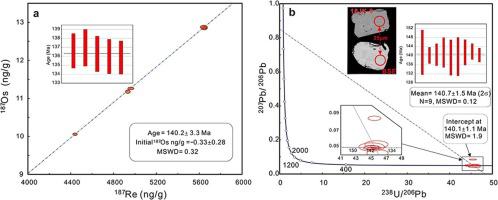当前位置:
X-MOL 学术
›
Ore Geol. Rev.
›
论文详情
Our official English website, www.x-mol.net, welcomes your feedback! (Note: you will need to create a separate account there.)
Ore genesis of the Baishawo Be-Li-Nb-Ta deposit in the northeast Hunan Province, south China: Evidence from geological, geochemical, and U-Pb and Re-Os geochronologic data
Ore Geology Reviews ( IF 3.3 ) Pub Date : 2021-02-01 , DOI: 10.1016/j.oregeorev.2020.103895 Chun-Hua Wen , Yong-Jun Shao , Yi-Qu Xiong , Jian-Kang Li , Shao-Yong Jiang
Ore Geology Reviews ( IF 3.3 ) Pub Date : 2021-02-01 , DOI: 10.1016/j.oregeorev.2020.103895 Chun-Hua Wen , Yong-Jun Shao , Yi-Qu Xiong , Jian-Kang Li , Shao-Yong Jiang

|
Abstract The Baishawo deposit is a newly discovered large pegmatite type Be-Li-Nb-Ta deposit that located at the NE Hunan province, South China, with estimated reserves of 16,160 t BeO @ 0.084%, 11,280 t Li2O @ 0.85%, and 3450 t (Ta2O5 + Nb2O5) @ 0.201%. The mineralized pegmatites are mainly hosted in the two-mica monzogranite, suggesting a possibly genetic relationship. Mineral assemblages and textures of pegmatites indicate the Baishawo deposit likely belong to LCT-type. The ore-related two-mica monzogranites have high contents of SiO2 and K2O, belong to strongly peraluminous rocks with A/CNK values of 1.13–1.24, and show S-type and highly evolved features. Zircons from the two-mica monzogranite show a eHf(t) range from −14.1 to −8.0 (average −10.1) and molybdenites from pegmatites show Re contents of 7.06–8.98 μg/g, both indicating that these rocks were likely sourced from the crust materials. The Baishawo two-mica monzogranite yields a LA-ICP-MS zircon U-Pb age of 147.5 ± 1.6 Ma, and the molybdenite from the mineralized pegmatites yields an Re-Os isochron age of 140.2 ± 3.3 Ma, which is in consistent with the coltan U-Pb age of 140.7 ± 1.5 Ma, indicating an Early Cretaceous mineralization age. The obtained ages combined with previous studies in the region indicate that the Early Cretaceous (~140 Ma) is an important rare metal mineralization period in South China.
更新日期:2021-02-01


























 京公网安备 11010802027423号
京公网安备 11010802027423号